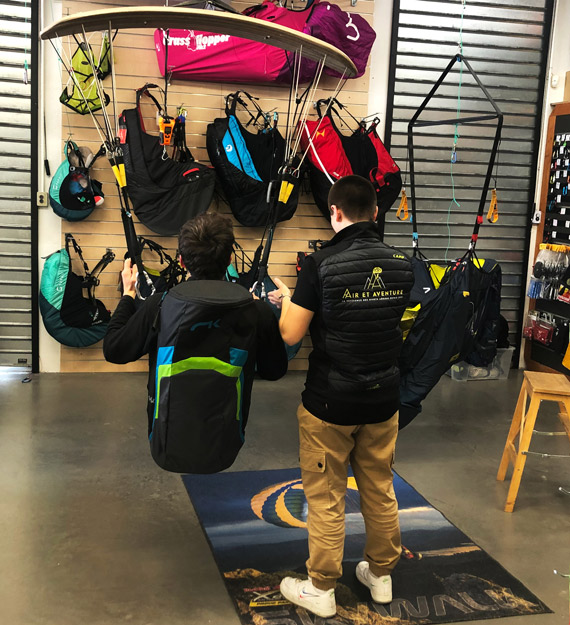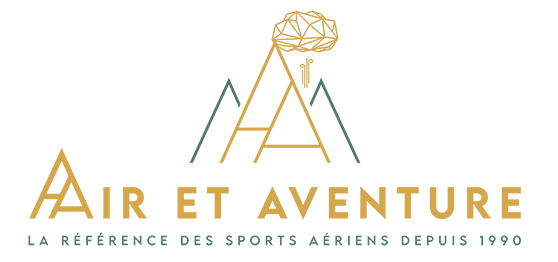PARAGLIDER REVISION: WHEN AND HOW TO HAVE YOUR EQUIPMENT CHECKED ?


Paragliding is an exciting aerial sport that offers an incomparable feeling of freedom. However, to guarantee your safety, avoid a paragliding accident and maximize your enjoyment, it's essential to take good care of your equipment. Checking your paraglider and testing your paragliding equipment are crucial steps in this process. In this article, we'll explain in detail when and how to have your equipment checked, where to do it, and how much it can cost you.
HOW DOES A PARAGLIDER EQUIPMENT CHECK WORK ?
Before diving into the details of when, where and how much, let's first take a look at the process of checking your paraglider. This step is essential to ensure that your equipment is in good working order and poses no risk to your safety in the air.
Checking your paragliding equipment is usually carried out by qualified professionals, such as instructors or authorized repair technicians. Here are the typical steps in the inspection process :
1. Visual inspection : The professional starts by visually inspecting your paraglider as a whole. They look for obvious signs of damage, such as tears, loose seams, or worn areas.
2. Line check : The lines are a crucial part of your glider. The technician checks their condition, making sure they are neither damaged nor worn. He also measures their length to ensure even load distribution, in line with manufacturers' recommendations.
3. Checking connecting elements and hardware : All connecting elements, such as carabiners and pulleys, are carefully examined to ensure that they are secure and in good condition.
4. Controls check: Your glider's brake controls are examined to ensure that they are securely attached to the lines.
5. Fabric inspection : The paraglider's fabric is examined for signs of wear, discoloration or brittleness. If necessary, repairs can be made to restore the integrity of the material.
6. Tackle check : Tackles are visually checked for damage.
7. Flight test : Once all checks and repairs have been completed, a flight test phase can be carried out to ensure that the glider performs to safety standards. This also ensures that adjustments are correct. From take-off to landing, to thermalling, all areas will be tested to ensure that everything is right.
Once all these steps have been successfully completed, your paraglider is ready for safe use.
1. Visual inspection : The professional starts by visually inspecting your paraglider as a whole. They look for obvious signs of damage, such as tears, loose seams, or worn areas.
2. Line check : The lines are a crucial part of your glider. The technician checks their condition, making sure they are neither damaged nor worn. He also measures their length to ensure even load distribution, in line with manufacturers' recommendations.
3. Checking connecting elements and hardware : All connecting elements, such as carabiners and pulleys, are carefully examined to ensure that they are secure and in good condition.
4. Controls check: Your glider's brake controls are examined to ensure that they are securely attached to the lines.
5. Fabric inspection : The paraglider's fabric is examined for signs of wear, discoloration or brittleness. If necessary, repairs can be made to restore the integrity of the material.
6. Tackle check : Tackles are visually checked for damage.
7. Flight test : Once all checks and repairs have been completed, a flight test phase can be carried out to ensure that the glider performs to safety standards. This also ensures that adjustments are correct. From take-off to landing, to thermalling, all areas will be tested to ensure that everything is right.
Once all these steps have been successfully completed, your paraglider is ready for safe use.
WHEN SHOULD YOU HAVE YOUR PARAGLIDER SERVICED ?
How often you should have your paraglider serviced depends on a number of factors, including your level of experience, how often you fly, and the conditions in which you fly. However, here are some general guidelines to help you determine when to schedule an overhaul :
For beginners : If you're just starting out and are a beginner paraglider pilot, we recommend that you have your glider serviced at least once a year or every two years, depending on how often you fly, even if you don't fly much. This frequency ensures that your equipment is always in good condition for your first flying adventures and paragliding outings.
For experienced pilots : More experienced pilots who fly regularly can, if they are able, visually inspect their wing on a regular basis. Intensive use can lead to more rapid wear and tear on the equipment, and more frequent servicing can detect potential problems before they become critical. For checks on the wing's trim (line length), they'll need to go to a professional with a measuring bench.
For beginners : If you're just starting out and are a beginner paraglider pilot, we recommend that you have your glider serviced at least once a year or every two years, depending on how often you fly, even if you don't fly much. This frequency ensures that your equipment is always in good condition for your first flying adventures and paragliding outings.
For experienced pilots : More experienced pilots who fly regularly can, if they are able, visually inspect their wing on a regular basis. Intensive use can lead to more rapid wear and tear on the equipment, and more frequent servicing can detect potential problems before they become critical. For checks on the wing's trim (line length), they'll need to go to a professional with a measuring bench.
After flights in difficult conditions : If you have flown in extreme weather conditions, such as strong winds or wet weather, we recommend that you have your glider checked more frequently to ensure that it has not suffered any damage.
After an incident : If you've had an accident, or if your glider has suffered even a minor impact, it's imperative to have it checked immediately. Damage can be visual (tears, damaged lines), and it can compromise the safety of your flight.
After flights in difficult conditions : If you have flown in extreme weather conditions, such as strong winds or wet weather, we recommend that you have your glider checked more frequently to ensure that it has not suffered any damage.
After an incident : If you've had an accident, or if your glider has suffered even a minor impact, it's imperative to have it checked immediately. Damage can be visual (tears, damaged lines), and it can compromise the safety of your flight.
WHERE TO HAVE YOUR PARAGLIDER SERVICED ?
The choice of where to have your paraglider serviced is just as important as the frequency of servicing. You need to make sure that the professional or workshop you choose is qualified and reliable. Here are a few options for having your glider serviced :
1. Approved repair shops : Repair shops approved by paraglider manufacturers are often the best option. They have the expertise to work on specific equipment, and are generally held to strict quality standards.
2. Paragliding schools : Many paragliding schools offer glider overhaul services. These schools often have qualified and experienced instructors who can guarantee the safety of your equipment.
3. Specialist stores : Some specialist air sports stores also offer glider overhaul services. Make sure they have the qualifications and expertise to carry out a complete check.
4. Independent repairers : If you choose an independent repairer, make sure they are certified and have a solid reputation in the paragliding community. Ask for references and opinions from other pilots.
5. Community recommendations : Don't hesitate to ask other experienced paragliders for recommendations. They can share their experiences and point you in the direction of trusted professionals.
Whatever your choice, be sure to ask about the certifications, experience and rates of the professional or workshop before entrusting your glider to be serviced.

HOW MUCH DOES IT COST TO HAVE YOUR PARAGLIDER CHECKED ?
The cost of checking your paraglider can vary depending on several factors, including the complexity of the check, the type of glider you have, and where you choose to have it checked. Here are a few things to consider when it comes to costs:
- Necessary repairs : If your glider requires repairs, this will increase the total cost of the overhaul. Be sure to ask for a detailed estimate before entrusting your equipment.
- Where you do the overhaul : Prices at approved workshops, paragliding schools and specialist stores can vary. It's a good idea to compare prices and choose the option that best suits your budget.
- The type of overhaul carried out : There are several types of overhaul, including simple checks (visual inspection), rigging checks (measuring and adjusting the size of the lines), etc. Each of these services will take a greater or lesser amount of time to carry out, and will therefore involve a greater or lesser cost, depending on the service performed.
In general, the cost of overhauling a paraglider can vary from around a hundred euros for a simple check-up to 300 euros for a complete inspection. For repairs, the cost depends on the complexity of the job. Don't hesitate to ask for a quote from the workshop concerned. It's essential to consider overhaul as an investment in your safety and flying pleasure.
In conclusion, servicing your paraglider is a crucial step in guaranteeing your safety in flight. It should be carried out regularly by qualified professionals, according to your level of experience and the use you make of your equipment. Choosing where to have your glider serviced and managing costs are also important considerations in maximizing your paragliding experience. Never forget that safety comes first, and a well-functioning glider will help you to enjoy the thrills and spills of the skies.
DISCOVER ALL THE PARAGLIDING FAQ :
Paragliding FAQ: Frequently Asked Questions about Paragliding
Paraglider wing folding step by step
Storage of paragliding equipment: how to maintain your equipment ?
Paragliding weather: what are the best conditions for paragliding ?
How to choose a paragliding school ?
Paragliding airspace: how does it work ?
Where to buy paragliding equipment ?
What are the requirements for registering a paramotor wing in France ?







